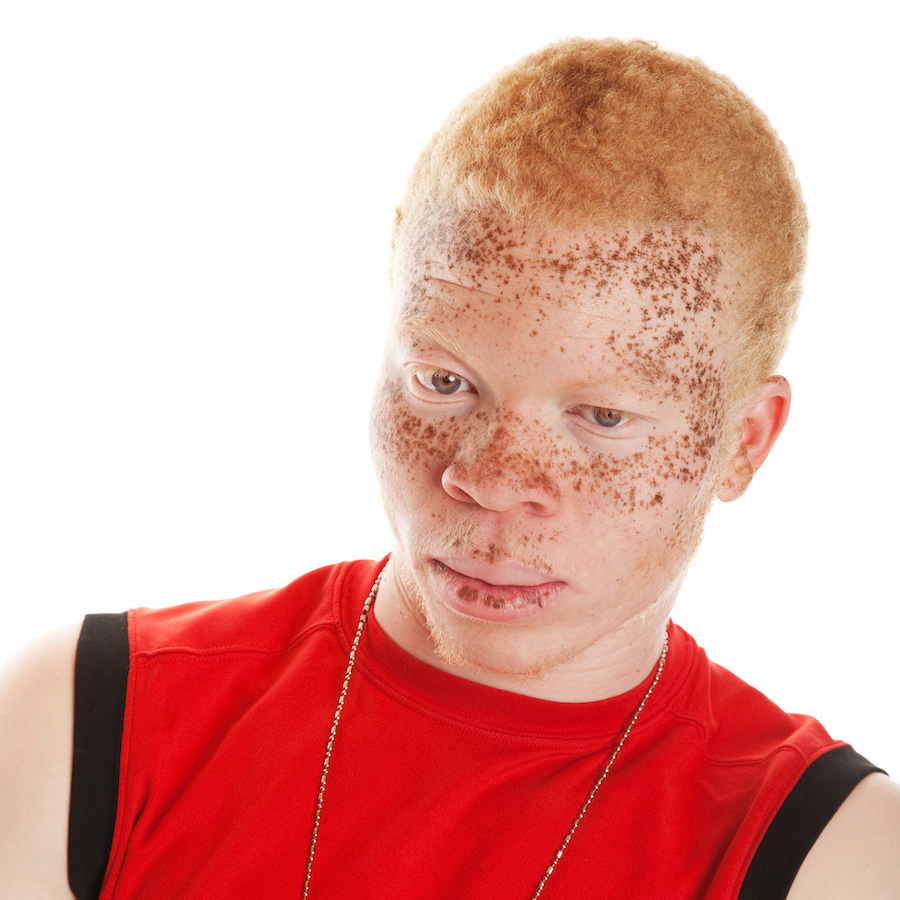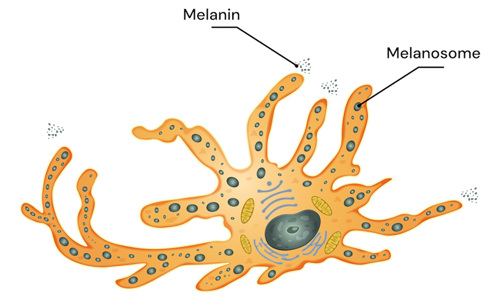
How is it that red hair shows up in people of African descent?
November 10, 2004

- Related Topics:
- Red hair,
- Pigmentation traits,
- Autosomal recessive inheritance,
- Hair color,
- Albinism
A curious adult from California asks:
“How is it that red hair shows up in people of African descent?”
A redhead of African descent is pretty rare. Except when people are of mixed ancestry, red hair in Africans is usually caused by a kind of albinism.
When people think of albinism, they may picture people with white hair, pale skin and pink eyes. But the reality is different! Albinism comes in many different varieties, and can look different on different people. (And pink eyes are extremely rare in humans. Most people with albinism have blue eyes.)
There’s one type in particular that causes red hair in people with African ancestry: rufous albinism (or “OCA3 albinism”). People with this condition have a red-bronze skin color, ginger-red hair, and blue or brown eyes.
What is albinism?
All of our coloring -- our skin, hair, and eye colors -- comes from melanin. Melanin is just a pigment, or colored chemical substance, like the ones that are used to dye your clothes or maybe even your hair!
Melanin comes in two different forms -- pheomelanin (the red kind) and eumelanin (the brown kind).
People with albinism don’t make melanin in the same way. Some forms of albinism lead to almost no melanin production. Other types of albinism just have less melanin production.

Albinism is caused by genetic differences. Specifically, differences in genes that are involved in making melanin.
Why are so many genes involved? To make each kind of melanin, your cells have to carry out several chemical steps. It's kind of like an assembly line. And just like in an assembly line where a separate person does each step in the process of making a product, your cells use a separate gene to take care of each step in the chemical process for making melanin.
Remember, a gene is a recipe for making a specific protein. Making melanin requires lots of special proteins called enzymes. Enzymes are just proteins that can bind to a chemical or protein and make a chemical reaction happen. They're the workers in the assembly lines of your cells.
A mutation can happen in the gene coding for any one of the enzymes involved in making melanin, leading to the enzyme not doing its job. Depending on how far into the process of making melanin that enzyme is, the end product will be different.
Imagine an assembly line for a toy truck. If the person who puts the wheels on didn't do his job, then the truck wouldn't be able to roll. But if instead further down the line the person who paints the truck doesn't do her job, the truck would still roll but not be the usual color. The same thing can happen in the pathway to make melanin -- depending on which enzyme is missing, the end product melanin can be changed in different ways.
The red hair in rufous albinism is caused by a difference in a gene called TYRP1. The protein made by this gene is thought to be involved in bringing together all the enzymes needed to make brown melanin.
But melanin production isn’t totally derailed. The red pigment can still be made, which is why they still have some coloring and the red hair.

Is all red hair caused by albinism?
Well, no. The red hair seen in people with European ancestry is caused by a mutation in a gene called MC1R.
MC1R is involved in determining the balance of two variations of melanin in the body. If this gene doesn’t work properly, you end up with more of "the red kind" than "the brown kind." Since both types of melanin are still made, this is not a type of albinism.

Redheads are pretty rare, but why? Is there a reason certain genetic characteristics would be rare?
A rare genetic trait is often one that is hurtful in some way that gets weeded out of the population. But the redheaded people you see all around you are happy, healthy people. It doesn't seem like their hair color is hurting them. In fact, it's kind of cool!
The thing is that these days, having red hair and light skin can't really hurt you because we spend a lot less of our time outside than our ancient ancestors did, and we have modern day conveniences like sunscreen. But 100,000 years ago when the first humans were evolving, things were a lot different.
Our ancestors first developed in Africa where the sunlight is really strong, so they needed the protection that comes from darker skin. Red hair and light skin would have been very unhealthy, so it was selected against.
But “selected against” is not the same thing as “removed entirely”. Many of these genetic differences are recessive. That means you can have one of them, but not have any visible differences. And that you can pass that genetic difference on to future generations.
As some people moved out of Africa they probably took some of these genetic differences with them. And as people moved farther north and into Europe, the sun's rays were less intense and they could afford to have mutations in their melanin system that gave them lighter skin and hair. That let those genetic differences become more common. That's probably how we got the red heads today who so often trace their roots to Northern Europe.
Groups who stayed in Africa would have still had some people with melanin mutations who survived and passed this trait on to future generations. That's how there are modern day Africans with red hair. It just turns out that the most common mutation that stayed in the African population is different than the one that traveled north.
Read More:
- Rarediseases.gov: More on the genetics of rufous albinism
- Albinism.org: Types of albinism

Author: Erin Cline
When this answer was published in 2004, Erin was a Ph.D. candidate in the Department of Molecular and Cellular Physiology, studying epithelial cell polarity and protein localization in James Nelson's laboratory. Erin wrote this answer while participating in the Stanford at The Tech program.
 Skip Navigation
Skip Navigation
